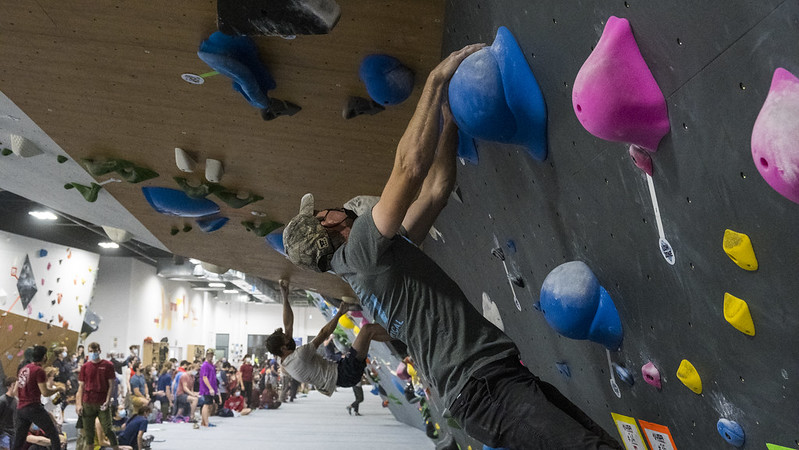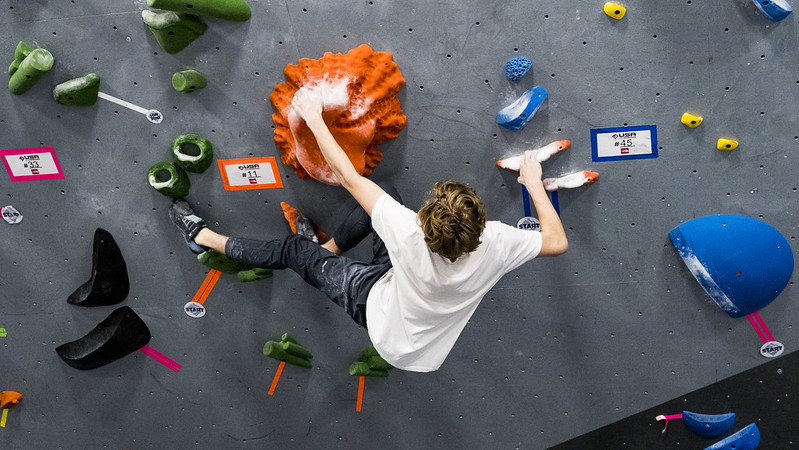Have you ever looked at a climb, seen more than one sloper on it, and declared you’ll never touch the climb because there aren’t enough crimps? Going out on a limb here, if you thoroughly enjoyed powering your way through slopey climbs, you wouldn’t have clicked on this article.
Perhaps you’ve shied away from slopers because they seem daunting or uncomfortable. But here’s the truth: slopers, typically found on higher-level climbs (V4 and up), are more conquerable than you might think. The key to confidently tackling slopers is mastering proper body positioning, muscle engagement, and mental cues. You’ve got this.
What Is A Sloper?

Let’s backtrack for a second. A sloper is a big, round, bulbous hold lacking a definitive edge to pull down on. It can range in size from a melon to a basketball with varying degrees of angles. They require more power and intentional body positioning to feel usable. But don’t worry, with the basics covered, you’re well on your way to learning how to improve your climbing: slopers edition.
How to Use Slopers Effectively
1. Use a wide-open hand grip.
Unlike a crimp, where you bend your fingers to general power, you want to use an open-hand grip on slopers. Think of cupping your hand around the hold and slightly spreading your fingers. The goal is to increase the contact surface area and generate more friction. On certain slopers, you may be able to compress the hold with part of your wrist and forearm. Or, you may be able to “meat hook” the hold by wrapping your wrist over the top.
2. Sink Your Weight Low
You want to keep your center of mass below the hold. Sink more of your weight into your legs until you’re ready to move to the next hold.
3. Keep Your Hips Close to the Wall
In addition to #2, sinking low, stay under the hold with your hips close to the wall. This positioning will give you the best leverage. A mental cue is to check the position of your elbows. You are likely in a good position if they are straight under the hold. If they are flaring out to the side or at the same height as the hold, you are spending excess energy, and your grip may slip quickly.
4. Lean Away
In the case where the sloper has an angled side, you need to grab and lean your hips away from the direction of the angle. With slopers, it’s all about maximizing leverage. Leaning away creates friction that enables you to stay on the wall, whereas your hands will slide off the hold if you lean in the same direction as the angle. Think of a doorframe. If you wanted to pull on the side of the frame, your hips would have to be to the side of it; you couldn’t stand in line with the door and be able to pull against the frame.
5. Straight Arms
The natural inclination of beginners is to hold slopers with bent arms. Climbers who know how to use slopers effectively avoid this as it leads to over-gripping and pumps out forearms and biceps. Instead, keep your arms as straight as possible. You’ll need to engage your muscles to a degree, but don’t keep your arms bent at 90 degrees. For all the math nerds, think of keeping a 120-degree angle. When you’re ready to move off the sloper, you may pull through a bent arm position, but you never want to be in that position for more than a few seconds.

Building Strength
The best way to improve at climbing on slopers is to climb on them and learn body positioning. However, increased core, shoulder, and chest strength can also help. In the gym, you’ll want to focus on exercises like chest presses, planks (different variations), archer push-ups, and overhead shoulder presses.
Next time you see a climb with slopers, don’t shy away. Challenge yourself to try it. Revisit these tips and try the techniques out. You may not send the climb on the first go, but remember, practice is the only way to improve. Be intentional with your body position and avoid wasting too much energy. Add some strength training targeting the chest, core, and shoulders, and you’ll be on your way to improving your climbing ability on slopers. Keep at it, and you’ll see progress. Comment below any questions you have about the tips shared in this article!

Recent Comments